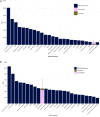The health impact of long COVID during the 2021-2022 Omicron wave in Australia: a quantitative burden of disease study
- PMID: 37011639
- PMCID: PMC10244043
- DOI: 10.1093/ije/dyad033
The health impact of long COVID during the 2021-2022 Omicron wave in Australia: a quantitative burden of disease study
Erratum in
-
Correction to: The health impact of long COVID during the 2021-2022 Omicron wave in Australia: a quantitative burden of disease study.Int J Epidemiol. 2023 Jun 6;52(3):967. doi: 10.1093/ije/dyad069. Int J Epidemiol. 2023. PMID: 37196322 Free PMC article. No abstract available.
Abstract
Background: Long COVID symptoms occur for a proportion of acute COVID-19 survivors, with reduced risk among the vaccinated and for Omicron compared with Delta variant infections. The health loss attributed to pre-Omicron long COVID has previously been estimated using only a few major symptoms.
Methods: The years lived with disability (YLDs) due to long COVID in Australia during the 2021-22 Omicron BA.1/BA.2 wave were calculated using inputs from previously published case-control, cross-sectional or cohort studies examining the prevalence and duration of individual long COVID symptoms. This estimated health loss was compared with acute SARS-CoV-2 infection YLDs and years of life lost (YLLs) from SARS-CoV-2. The sum of these three components equals COVID-19 disability-adjusted life years (DALYs); this was compared with DALYs from other diseases.
Results: A total of 5200 [95% uncertainty interval (UI) 2200-8300] YLDs were attributable to long COVID and 1800 (95% UI 1100-2600) to acute SARS-CoV-2 infection, suggesting long COVID caused 74% of the overall YLDs from SARS-CoV-2 infections in the BA.1/BA.2 wave. Total DALYs attributable to SARS-CoV-2 were 50 900 (95% UI 21 000-80 900), 2.4% of expected DALYs for all diseases in the same period.
Conclusion: This study provides a comprehensive approach to estimating the morbidity due to long COVID. Improved data on long COVID symptoms will improve the accuracy of these estimates. As data accumulate on SARS-CoV-2 infection sequelae (e.g. increased cardiovascular disease rates), total health loss is likely to be higher than estimated in this study. Nevertheless, this study demonstrates that long COVID requires consideration in pandemic policy planning, given it is responsible for the majority of direct SARS-CoV-2 morbidity, including during an Omicron wave in a highly vaccinated population.
Keywords: COVID-19; burden of disease; epidemiology; long COVID.
© The Author(s) 2023. Published by Oxford University Press on behalf of the International Epidemiological Association.
Conflict of interest statement
The Population Interventions Unit is expected to receive funding from Moderna Inc. to conduct research on COVID-19 vaccine effectiveness in Victoria, Australia. No other conflicts of interest are declared.
Figures



References
MeSH terms
Supplementary concepts
LinkOut - more resources
Full Text Sources
Medical
Research Materials
Miscellaneous

